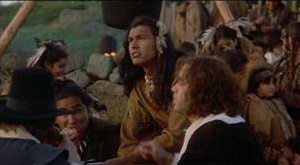
With Thanksgiving right around the corner, it seems as appropriate time to examine the real life of a native whose assistance has traditionally been credited with helping the Pilgrims survive in this new world: Squanto.
Usually Squanto's role is boiled down to one or two sentences, something like "he helped the Pilgrims by showing them how to grow corn using fish as fertilizer." That trivialization ignores the other facets of his life.
Although his exact birth date is unknown, many historians use either January 1, 1585, or January 1, 1592. He was born near present day Plymouth, Massachusetts and belonged to the Patuxet band of the Wampanoag tribe.
It is thought that Squanto was abducted and brought to Europe sometime in the early 1600s, although by who, exactly when and where he was taken (England or Spain) is a matter of dispute. All that can be said for certain is that Squanto learned to speak English – a skill that would come in handy when he returned to America.

In 1619 Squanto finally returned to his native land, in a ship along with Captain John Smith. However, in his absence the Patuxet, along with other native tribes, had been decimated by a disease (possibly smallpox) brought by the Europeans.
Squanto was taken prisoner by the Wampanoag tribe, and it was likely that he was still a captive there when the chief, Massasoit, decided to contact the Pilgrims in the spring of 1621 and relate the native's friendly intentions. Thanks to Squanto acting as a go-between between the Wampanoag and the Europeans, the two groups signed a treaty pledging friendship.
Squanto came to live with the English settlers. His advice and counsel proved critical to the Europeans in helping them to survive in this new land. However, the famous story of him teaching the Pilgrims how to grow corn the native way by fertilizing it with fish has become more doubtful over the years, as it seems he may have learned the technique in Europe or Newfoundland. Squanto did, however, introduce the English to other native peoples in the area, and helped them to trade with them for needed supplies and provisions.

However, there was also a dark side to Squanto's character. He used his special relationship with the Europeans to increase his stature among the other natives, sometimes threatening to have the English unleash evil onto the natives if he did not get his way. He once plotted an elaborate hoax to discredit Massasoit that so angered the chief that he wanted Squanto killed. The Pilgrims agreed, but saved Squanto anyway because of his usefulness.
Some speculate that Squanto's contentious relationship with Massasoit led to him being poisoned by the Wampanoag in 1623. The Pilgrims mourned his death as a great loss. While there is much uncertainty about Squanto's life, the one thing known for sure is that there is more to the story than just a sentence or two about growing corn.
Too often, Native Americans have suffered the same fate in the telling of American history as have African-Americans. The role of native peoples has been either ignored or trivialized because of America's imperial and racist attitudes.
Why not during this Thanksgiving holiday, pause and think of the efforts and contributions efforts all Americans who have made this nation great.
